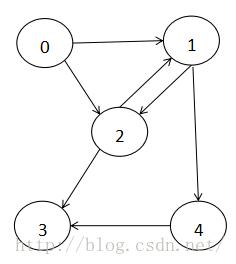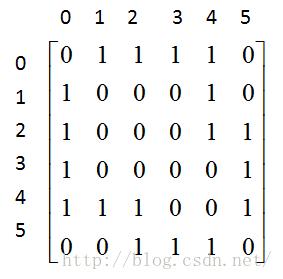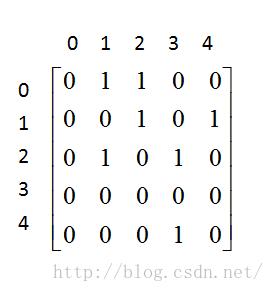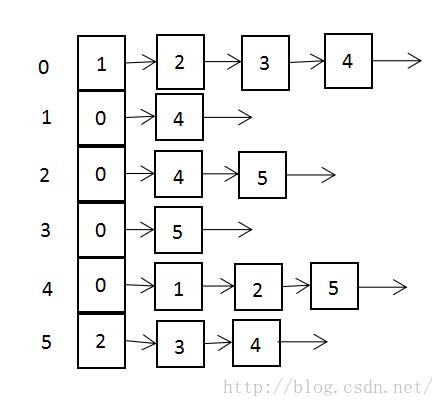java数据结构之图(邻接矩阵和邻接表)
Posted xxniuren
tags:
篇首语:本文由小常识网(cha138.com)小编为大家整理,主要介绍了java数据结构之图(邻接矩阵和邻接表)相关的知识,希望对你有一定的参考价值。
JAVA数据结构之图
1、图的介绍和原理
1.1、图的基本概念
图是由顶点集(VertexSet)和边集(EdgeSet)组成,针对图G,顶点集和边集分别记为V(G)和E(G)。依据图的边集是否为有向,可把图分为有向图和无向图,根据图是否有权重,可以分为有权图和无权图。 图的基本术语: 1:邻接点----在一个无向图中,若存在一条边(Vi,Vj),则称Vi,Vj为此边的两个端点,并称它们互为邻接点; 2:出/入边 -----在一个有向图张,若存在一条边<Vi,Vj>,则称此边为顶点Vi的出边,顶点Vj的一条入边; 3:度/入度/出度----无向图中的度定义为以该顶点为一个端点的边的数目,记为D(V)。有向图的入度定义为多少边指向该顶点,出度是该顶点出边的个数;1.2、图的表示方式之邻接矩阵
图的表示方式有两种:二维数组表示(邻接矩阵);链表表示(邻接表)。邻接矩阵是表示图形中顶点之间相邻关系的矩阵,对于n个顶点的图而言,矩阵是的row和col表示的是1....n个点。对于无向图 如果顶点b1和b2是连接的,那么在二维矩阵中matrix[b1,b2]和matrix[b2,b1]位置的值置为1,如果是有向图b1指向b2,那么 matrix[b1,b2]=1,matrix[b2,b1]=0;下面用一个例子表示无向图和有向图的邻接矩阵;

 无向图
有向图
上面的无向图用邻接矩阵表示的话为: 该有向图用邻接矩阵来表示的话:
无向图
有向图
上面的无向图用邻接矩阵表示的话为: 该有向图用邻接矩阵来表示的话:


如果图是一个带权图,需要把1换为相应边上的权值,把非对角线上的换成一个很大的特定的实数则可,表示相应的边不存在,这个特定的实数通常用无穷大或MaxValue来表示,他要大于图G中所有边的权值(这里就不多加以举例)。
1.3、图的表示方式之邻接表
邻接矩阵与邻接表相比,它会造成空间的一定损失,它需要为每个顶点都分配n个边的空间,其实有很多边都是不存在边,但是邻接表的实现就不一样,它只关心存在的边,不关心不存在的边。邻接表由数组+链表组成对于上面的无向图,邻接表表示为(由于有向和无向的差别不是太大,所以只是画出了无向的邻接表表示):
该图标是为,标号为0的结点的相关联的结点为 1 2 3 4;标号为1的结点的相关联结点为0 4,标号为2的结点相关联的结点为 0 4 5......
2、图的实现
2.1、邻接矩阵表示图
边集数组用来存放边的信息,包括边的起点、终点和权重。边结点定义如下:package Graph;
//边集数组 ,存放边的信息
//邻域数组表示 和 邻域表表示 是两种不同的表示方式
//表示的是插入边的元素,边的起点和终点 边的权重
public class EdgeElement
int fromvex;
int endvex;
int weight;
public EdgeElement(int v1,int v2)
//对于无权重图的初始化
fromvex=v1;
endvex=v2;
weight=1;
public EdgeElement(int v1,int v2,int wgt)
//对于有权重图的初始化
fromvex=v1;
endvex=v2;
weight=wgt;
package Graph;
//可以通过边集来得到一个图的构成
public interface Graph
void creatGraph(EdgeElement d[]); //通过边结点来构建一个图
GraphType graphType(); //返回图的类型 无向无权图 无向有权图 有向无权图 有向有权图 定义一个枚举变量
int vertices(); //返回图的顶点数
int edges(); //返回图的边数
boolean find(int i,int j); //从图中查找一条边(i,j)是否存在
void putEdge(EdgeElement theEdge); //像图中插入一条边 theEdge
void removeEdge(int i,int j); //从图中删除一条边
int degree(int i); //返回顶点i的度
int inDegree(int i); //返回顶点i的入度
int outDegree(int i); //返回顶点i的出度
void output(); //以图的顶点集和边集的形式输出一个图
void depthFirstSearch(int v); //从顶点v开始深度优先搜索整幅图
void breadthFirstSearch(int v); //从顶点v开始广度优先搜索整幅图
//在邻域数组中写数据
public void creatGraph(EdgeElement[] d)
int i;
for(i=0;i<d.length;i++)
if(d[i]==null) break;
int v1,v2;
v1=d[i].fromvex;
v2=d[i].endvex;
if(v1<0 || v1>n-1 || v2<0 || v2>n-1 || v1==v2)
System.out.println("边的顶点序号无效,退出运行");
System.exit(0);
if(type==GraphType.NoDirectionNoWeight)
a[v1][v2]=a[v2][v1]=1;
else if(type==GraphType.NoDirectionWeight)
a[v1][v2]=a[v2][v1]=d[i].weight;
else if(type==GraphType.DirectionNoWeight)
a[v1][v2]=1;
else
a[v1][v2]=d[i].weight;
e=i; //边的数目
public void putEdge(EdgeElement theEdge)
int v1,v2;
v1=theEdge.fromvex;
v2=theEdge.endvex;
if(v1<0 || v1>n-1 || v2<0 || v2>n-1 || v1==v2)
System.out.println("边的顶点序号无效,退出运行!");
System.exit(0);
if(a[v1][v2]==0 || a[v1][v2]==MaxValue) e++; //边数e的值加一
if(type==GraphType.NoDirectionNoWeight || type==GraphType.NoDirectionWeight)
if(type==GraphType.NoDirectionNoWeight)
a[v1][v2]=a[v2][v1]=1;
else
a[v1][v2]=a[v2][v1]=theEdge.weight;
else
if(type==GraphType.DirectionNoWeight) a[v1][v2]=1;
else
a[v1][v2]=theEdge.weight;
public void removeEdge(int i, int j)
if(i<0 || i>n-1 || j<0 || j>n-1 || i==j)
System.out.println("边的顶点序号无效,退出运行!");
System.exit(0);
if(a[i][j]==0 || a[i][j]==MaxValue)
System.out.println("要删除的边不存在,退出运行!");
System.exit(0);
if(type==GraphType.NoDirectionNoWeight)
a[i][j]=a[j][i]=0;
else if(type==GraphType.NoDirectionWeight)
a[i][j]=a[j][i]=MaxValue;
else if(type==GraphType.DirectionNoWeight)
a[i][j]=0;
else a[i][j]=MaxValue;
e--;
//得到该结点的度
public int degree(int i)
if(i<0 || i> n-1)
System.out.println("参数的顶点序号值无效,退出运行");
System.exit(0);
int k=0;
if(type==GraphType.NoDirectionNoWeight || type==GraphType.NoDirectionWeight)
for(int j=0;j<n;j++)
if(a[i][j]!=0 && a[j][i]!=MaxValue) k++;
else
k = inDegree(i)+outDegree(i);
return k;
//入度
public int inDegree(int i)
if(i<0 || i> n-1)
System.out.println("参数的顶点序号值无效,退出运行");
System.exit(0);
if(type==GraphType.NoDirectionNoWeight || type==GraphType.NoDirectionWeight)
return -1;
int k=0;
for(int j=0;j<n;i++)
if(a[j][i]!=0 && a[j][i]!=MaxValue) k++;
return k;
//出度
public int outDegree(int i)
if(i<0 || i> n-1)
System.out.println("参数的顶点序号值无效,退出运行");
System.exit(0);
if(type==GraphType.NoDirectionNoWeight || type==GraphType.NoDirectionWeight)
return -1;
int k=0;
for(int j=0;j<n;i++)
if(a[i][j]!=0 && a[i][j]!=MaxValue) k++;
return k;
//输出
public void output()
int i,j;
System.out.print("V=");//输出顶点集合
for(i=0;i<n-1;i++)
System.out.print(i+",");
System.out.print(n-1+"");//输出顶点集合
//输出边集合
System.out.print("E=");
if(type==GraphType.NoDirectionNoWeight || type==GraphType.DirectionNoWeight)
for(i=0;i<n;i++)
for(j=0;j<n;j++)
if(a[i][j]!=0 && a[i][j]!=MaxValue)
if(type==GraphType.NoDirectionNoWeight)
if(i<j)System.out.print("("+i+","+j+"),");
else
System.out.print("<"+i+","+j+">");
else
for(i=0;i<n;i++)
for(j=0;j<n;j++)
if(a[i][j]!=0 && a[i][j]!=MaxValue)
if(type==GraphType.NoDirectionWeight)
if(i<j)System.out.print("("+i+","+j+")"+a[i][j]+",");
else System.out.print("<"+i+","+j+">"+a[i][j]+",");
System.out.print("");
//深度优先进行搜索 是从哪个顶点开始遍历,这里可以用顶点序号表示顶点
public void depthFirstSearch(int v) //驱动函数
boolean visited[]=new boolean[n];
for(int i=0;i<n;i++)
visited[i]=false;
dfs(v,visited); //把每个结点遍历一次。
System.out.println();
//进行深度优先搜索的内部递归方法使用
private void dfs(int i,boolean visited[]) //工作函数
System.out.print(i+" ");
visited[i]=true;
for(int j=0;j<n;j++)
if(a[i][j]!=0 && a[i][j]!=MaxValue && !visited[j])
dfs(j,visited);
***************************************分割线*********************
2.2邻接表表示图(由于实现起来只是不太难的逻辑,所以代码不做太多解释)
邻接表结点定义,存储指向的结点,该结点的权重,还有该节点指向的下一个结点,具体代码实现如下:package GraphLink;
//定义邻接表类型
public class EdgeNode
//需要一个存储自身结点
int adjvex;
int weight;
EdgeNode next;
//无权图
public EdgeNode(int adj,EdgeNode nt)
this.adjvex=adj;
this.next=nt;
this.weight=1;
//有权图
public EdgeNode(int adj,int wgt,EdgeNode nt)
this.adjvex=adj;
this.weight=wgt;
this.next=nt;
//生成图函数
@Override
public void creatGraph(EdgeElement[] d)
int i;
for(i=0;i<d.length;i++)//处理边集合 如果边集合重复 那程序不就有问题了么 这点要处理
if(d[i]==null) break;
int v1,v2,weight;
v1=d[i].fromvex;
v2=d[i].endvex;
weight=d[i].weight;
if(v1<0||v1>n-1||v2<0||v2>n-1||v1==v2)
System.out.println("边的顶点序号无效,退出运行");
System.exit(0);
if(type==GraphType.NoDirectionNoWeight)//处理无方向 无权重的图
a[v1]=new EdgeNode(v2,a[v1]);//把边挂载在主干上,a为EdgeNode类型的一维数组
a[v2]=new EdgeNode(v1,a[v2]);//处理第二条边
else if(type==GraphType.NoDirectionWeight)//处理无向有权图
a[v1]=new EdgeNode(v2,weight,a[v1]);
a[v2]=new EdgeNode(v1,weight,a[v2]);
else if(type==GraphType.DirectionNoWeight)//处理有向无权图
a[v1]=new EdgeNode(v2,a[v1]);
else
a[v1]=new EdgeNode(v2,weight,a[v1]);
e=i;
//在图中查找一条边
public boolean find(int v1,int v2)
if(v1<0||v1>n-1||v2<0||v2>n-1||v1==v2)
System.out.println("边的顶点序号无效,退出运行");
System.exit(0);
EdgeNode p=a[v1];
while(p!=null)
if(p.adjvex==v2)
return true;
p=p.next;
return false;
//向图中插入一条边
public void putEdge(EdgeElement theEdge)
int v1,v2,weight;
v1=theEdge.fromvex;
v2=theEdge.endvex;
weight=theEdge.weight;
if(v1<0||v1>n-1||v2<0||v2>n-1||v1==v2)
System.out.println("边的顶点序号无效,退出运行");
System.exit(0);
EdgeNode p=a[v1];
while(p!=null)
if(p.adjvex==v2)
break;//退出后处理
p=p.next;
if(p==null) e++;
else
if(type==GraphType.DirectionWeight || type==GraphType.NoDirectionWeight)
p.weight=weight;
if(type==GraphType.NoDirectionWeight)//无向有权重的另一条边也要处理
EdgeNode q=a[v2];
while(q!=null)
if(q.adjvex==v1) break;
q=q.next;
q.weight=weight;
return;
if(type==GraphType.NoDirectionNoWeight)//如果是无向无权重
a[v1]=new EdgeNode(v2, a[v1]);
a[v2]=new EdgeNode(v1, a[v2]);
else if(type==GraphType.NoDirectionWeight)//处理无向有权重
a[v1]=new EdgeNode(v2,weight,a[v1]);
a[v2]=new EdgeNode(v1,weight,a[v2]);
else if(type==GraphType.DirectionNoWeight)//有向无权重
a[v1]=new EdgeNode(v2,a[v1]);
else
a[v1]=new EdgeNode(v2, weight,a[v1]);
public void removeEdge(int v1,int v2)
if(v1<0||v1>n-1||v2<0||v2>n-1||v1==v2)
System.out.println("边的顶点序号无效,退出运行");
System.exit(0);
EdgeNode p=a[v1],q=null;//拿到主干结点
while(p!=null)
if(p.adjvex==v2) break;
q=p;
p=p.next;
if(p==null)
System.out.println("要删除的边不存在,程序退出运行");
System.exit(0);
if(q==null)//该结点在表头上 主干的节点就是需要找的结点
a[v1]=a[v1].next;
else
q.next=p.next;//嫁接上
//删除无向图的另一个结点上的边
if(type==GraphType.NoDirectionNoWeight||type==GraphType.NoDirectionWeight)
EdgeNode p1=a[v2],q1=null;
while(p1!=null)
if(p1.adjvex==v1)
break;
q1=p1;
p1=p1.next;
if(q1==null)
a[v2]=a[v2].next;
else
q1.next=p1.next;
e--;
//返回一个顶点的度,度分为入度和出度,要分别处理
public int degree(int i)
if(i<0||i>n-1)
System.out.println("顶点超过了范围,程序退出运行");
System.exit(0);
int k=0;
if(type==GraphType.NoDirectionNoWeight||type==GraphType.NoDirectionWeight)
EdgeNode p=a[i];
while(p!=null)
k++;
p=p.next;
return k;
else return inDegree(i)+outDegree(i);
//求出并返回一个顶点的入度
public int inDegree(int i)//返回指向该顶点的度,入度,用双循环来实现
int k=0;//记录入度个数
if(i<0||i>n-1)
System.out.println("顶点超过了范围,程序退出运行");
System.exit(0);
if(type==GraphType.NoDirectionNoWeight||type==GraphType.NoDirectionWeight)
return -1;
else
for(int j=0;j<n;j++)
EdgeNode p=a[j];
while(p!=null)
if(p.adjvex==i)k++;
p=p.next;
return k;
//返回一个顶点的出度
public int outDegree(int i)
int k=0;//记录出度的数目
EdgeNode p=a[i];
while(p!=null)
k++;
p=p.next;
return k;
//得到邻接矩阵
public int[][] getAdjacencyMatrix()
int adjacencyMatrix[][]=new int[n][n];
if(type==GraphType.DirectionNoWeight||type==GraphType.DirectionWeight)//有向性
//有向 那不存在的边是存在一个InfinityValue
for(int i=0;i<n;i++)
for(int j=0;j<n;j++)
if(i==j) adjacencyMatrix[i][j]=0;
else adjacencyMatrix[i][j]=InfinityValue;
else
//无向 都设置为0
for(int i=0;i<n;i++)
for(int j=0;j<n;j++)
adjacencyMatrix[i][j]=0;
//遍历整个图
for(int i=0;i<n;i++)
EdgeNode p=a[i];
while(p!=null)
adjacencyMatrix[i][p.adjvex]=p.weight;
p=p.next;
return adjacencyMatrix;
以上是关于java数据结构之图(邻接矩阵和邻接表)的主要内容,如果未能解决你的问题,请参考以下文章